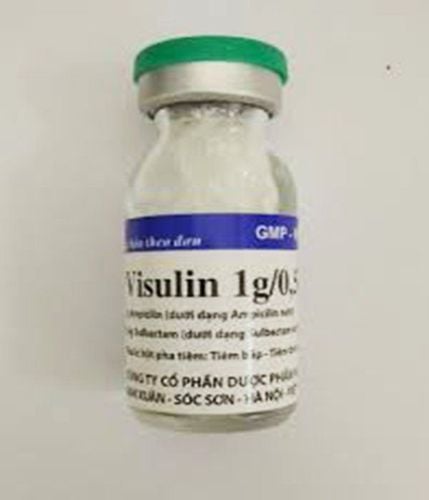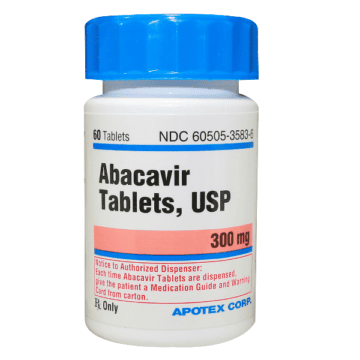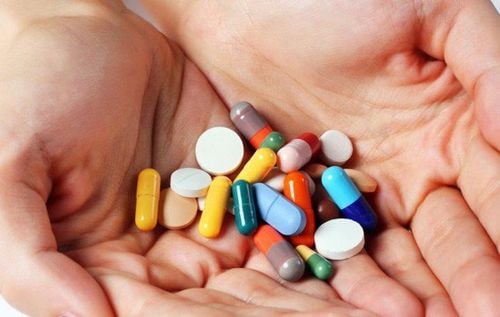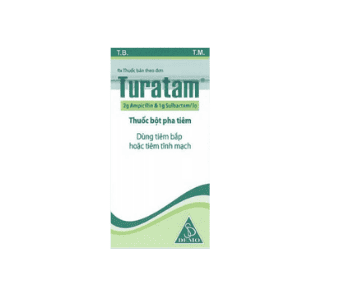This is an automatically translated article.
Hasulaxin 375 is made in the form of tablets, with the main ingredient being Sultamicillin. The drug is used in the treatment of certain infections caused by strains of bacteria that are sensitive to the active ingredient of the drug.
1. What is Hasulxin?
1 Hasulaxin 375 tablet contains Sultamicillin tosilate dihydrate corresponding to Sultamicillin 375mg and other excipients. After oral administration, Sultamicillin is hydrolyzed during absorption, forming Ampicillin and Sulbactam in a 1:1 ratio in the general circulation.
Ampicillin is a semi-synthetic antibiotic with a broad spectrum of action, antibacterial against many strains of gram-negative and gram-positive bacteria due to its ability to inhibit the biosynthesis of peptidoglycan of the bacterial cell wall. However, Ampicillin suffers from beta-lactamase breaking the beta-lactam ring, so its spectrum of action normally does not include bacteria that produce this enzyme.
Sulbactam is a penicilamic acid sulfonylurea, which is an irreversible beta-lactamase inhibitor. When used alone, Sulbactam has only relatively weak antibacterial activity. Sulbactam has good inhibitory activity on both chromosomal and plasmid-mediated beta-lactamases.
Sulbactam has high affinity, binds to some beta - lactamases (enzymes that inactivate Ampicillin) by hydrolysis of the beta - lactam ring. Therefore, the combination of Sulbactam with Ampicillin produces a bactericidal synergistic effect, helping to expand the antibacterial spectrum of Ampicillin to many strains of beta-lactamase producing bacteria that are resistant to Ampicillin used alone.
Indications for use of Hasulaxin 375: Treatment of infections caused by strains of bacteria sensitive to the active ingredients of the drug:
Superficial dermatitis, deep dermatitis or chronic pyoderma; Inflammation of the lymph nodes and lymph vessels; Respiratory tract infections: otitis media, sinusitis, tonsillitis, laryngitis, pharyngitis, pneumonia, lung abscess, acute bronchitis, chronic airway inflammation; Pyelonephritis, nephritis and cystitis; Uterine infection; Uncomplicated gonococcal infection; Keratitis (including keratitis), inflammation of the lacrimal sac. Contraindications to the use of Hasulaxin 375:
Patients with hypersensitivity to Sulbactam, penicillin or any other ingredients in the drug; Patients with infectious mononucleosis.
2. Usage and dosage of Hasulaxin 375
Usage: Orally. Patients can take Hasulaxin 375 with or without food.
Dosage:
Adults (including the elderly): The recommended dose is 375 - 750mg/time x 2 times/day. Treatment should be continued for 48 hours after the fever and symptoms are gone. The usual duration of treatment is 5-14 days, which can be extended if necessary; Children weighing less than 30kg: Use a dose of 25-50mg/kg/day, divided into 2 times depending on the degree of infection and the doctor's assessment; Children weighing over 30kg: Use the same dose as adults; Treatment of uncomplicated gonococcal infections: Use a single dose of 2.25g (equivalent to 6 tablets of 375mg). Can be combined with probenecid 1g to prolong plasma concentrations of Ampicillin and Sulbactam; Treatment of infections caused by hemolytic streptococci: Use the drug for at least 7 days to prevent rheumatic fever or acute glomerulonephritis; Patients with renal impairment: In patients with severe renal impairment (with creatinine clearance less than 30ml/min), the elimination of ampicillin and sulbactam is similar, so the ampicillin/sulbactam plasma ratio remains unchanged. The frequency of dosing should be reduced in this group of patients. Overdosage: Currently, relatively little is known about Sultamicillin overdose. Drug overdose mainly causes side effects similar to those. Neurological reactions (including convulsions) may occur if beta-lactam concentrations are high in the cerebrospinal fluid. The treatment is: Ampicillin and Sulbactam can be removed from the general circulation by hemodialysis. This process may increase the elimination of the drug in case of overdose in patients with renal impairment.
3. Side effects of Hasulaxin 375
When using Hasulaxin 375, patients may experience the following side effects:
Serious side effects:
Shock, anaphylactic reactions; Toxic skin necrosis syndrome, exfoliative dermatitis, Stevens - Johnson syndrome; Acute renal failure, interstitial nephritis; Blood disorders: Thrombocytopenia, leukopenia, hemolytic anemia; Liver dysfunction, jaundice. Patients should be closely monitored when taking Hasulaxin 375, if the above undesirable side effects appear, the drug should be discontinued, symptomatic treatment and supportive treatment measures taken when necessary.
Other side effects:
Hypersensitivity: Rash, urticaria, skin pruritus, angioedema, dermatitis, erythema multiforme; Blood: eosinophilia, leukopenia, neutropenia, agranulocytosis, thrombocytopenia, anemia; Liver: Increased AST, ALT, A1-P; Digestive: Diarrhea, loose stools, nausea, vomiting, abdominal pain, upset stomach, loss of appetite, hairy tongue, heartburn, indigestion; Fungal infections: Stomatitis ; Central nervous system: Convulsions, dizziness; Other side effects: Fever, malaise, headache, drowsiness, vitamin B deficiency symptoms (stomatitis, glossitis, anorexia, neuritis,...), vitamin K deficiency symptoms (appearance). blood, decreased blood prothrombin, ...), shortness of breath, fatigue. If the patient experiences the above side effects, the patient should inform the doctor so that appropriate measures such as dose reduction or discontinuation of the drug can be taken as necessary.
4. Be careful when using Hasulaxin 375
Before and while using Hasulaxin 375, patients should note:
In case patients infected with gonococcal disease have lesions suspected of having syphilis, they should be tested with a black background microscope before starting treatment. Treatment with sultamicillin and monthly serum tests for at least 4 consecutive months; Sultamicillin, as well as penicillin, can cause anaphylaxis and should therefore be used with respect to the usual precautions of penicillin therapy. Before initiating therapy, it is prudent to inquire into the patient's history of allergy to penicillins, cephalosporins and other drugs. If an allergic reaction occurs, the drug should be discontinued and appropriate therapeutic measures instituted. In severe cases, immediate emergency treatment with adrenaline is required. If necessary, the patient can be given oxygen, intravenous corticosteroids, and respiratory support (including intubation); Because antibiotics can cause pseudomembranous colitis, it is necessary to make a differential diagnosis when patients develop diarrhea during treatment with Sultamicillin; Because mononucleosis patients have a high rate of skin rashes during treatment with aminopenicillin, the use of sultamicillin should be avoided in this group of patients; Using Sultamicillin can cause some types of bacteria that are not sensitive to the drug to increase in number and cause disease, especially Pseudomonas and Candida. Therefore, the patient should be closely monitored, if superinfection is present, the drug should be discontinued and appropriate treatment measures used; Dosage of Sultamicillin should be reduced in patients with renal impairment; Avoid taking Hasulaxin 375 in people infected with HIV and Epstein-Barr virus; During treatment with Sultamicillin, it is recommended to periodically check the function of the liver, kidneys and blood-forming organs during treatment. This is especially important in infants, especially premature babies and infants; The major route of elimination of Ampicillin and Sulbactam following oral administration of Sultamicillin is via the urine. Because the renal function of the neonate is not yet complete, caution should be exercised when sultamicillin is administered to the neonate; Hasulaxin 375 contains castor oil as an excipient, which can cause stomach upset and diarrhea; The component Sulbactam crosses the placental barrier. Because the safety of Sultamicillin during pregnancy has not been fully evaluated, it is best not to use Sultamicillin during pregnancy (unless otherwise directed by a doctor); The use of Sultamicillin in nursing women is not recommended, as small amounts of Ampicillin and Sulbactam are excreted in breast milk; There are no reports of restrictions on the use of Sultamicillin in children; In the elderly, renal function may decline and the half-life of Sultamicillin may be prolonged. However, no dose adjustment is required in this group of subjects; Because Sultamicillin can cause dizziness, headache and drowsiness, caution should be exercised when using it in people who drive or operate machinery.
5. Hasulaxin drug interactions 375
Some drug interactions of Hasulaxin 375 include:
Oral probenecid competitively inhibits the renal tubular elimination of Ampicillin and Sulbactam, leading to prolonged and increased serum concentrations of these two drugs; Concomitant use of Hasulaxin with Allopurinol in patients with high blood uric acid may increase the frequency of rash; Ampicillin has an effect on the test results for glucose in the urine by the copper sulfate method but does not affect the test results by the glucose oxidase method; When used concurrently with anticoagulants, penicillins may alter platelet aggregation and coagulation test results; Bacteriostatic drugs such as erythromycin, chloramphenicol, tetracyclines and sulfonamides can interfere with the bactericidal effect of penicillins. Therefore, the concomitant use of Hasulaxin with the above drugs should be avoided; There have been reports of ampicillin reducing the effectiveness of contraception in women taking oral contraceptives. Therefore, if women are taking Hasulaxin, women should choose another effective method of contraception; Concomitant use of methotrexate with penicillins reduces clearance and increases methotrexate toxicity. Therefore, patients taking Hasulaxin should be closely monitored for methotrexate toxicity. When indicated to use Hasulaxin 375 to treat bacterial infections, patients should strictly follow all instructions of the doctor. This ensures optimal treatment effectiveness, significantly reducing the risk of unpredictable events and side effects.
Follow Vinmec International General Hospital website to get more health, nutrition and beauty information to protect the health of yourself and your loved ones in your family.
Please dial HOTLINE for more information or register for an appointment HERE. Download MyVinmec app to make appointments faster and to manage your bookings easily.













